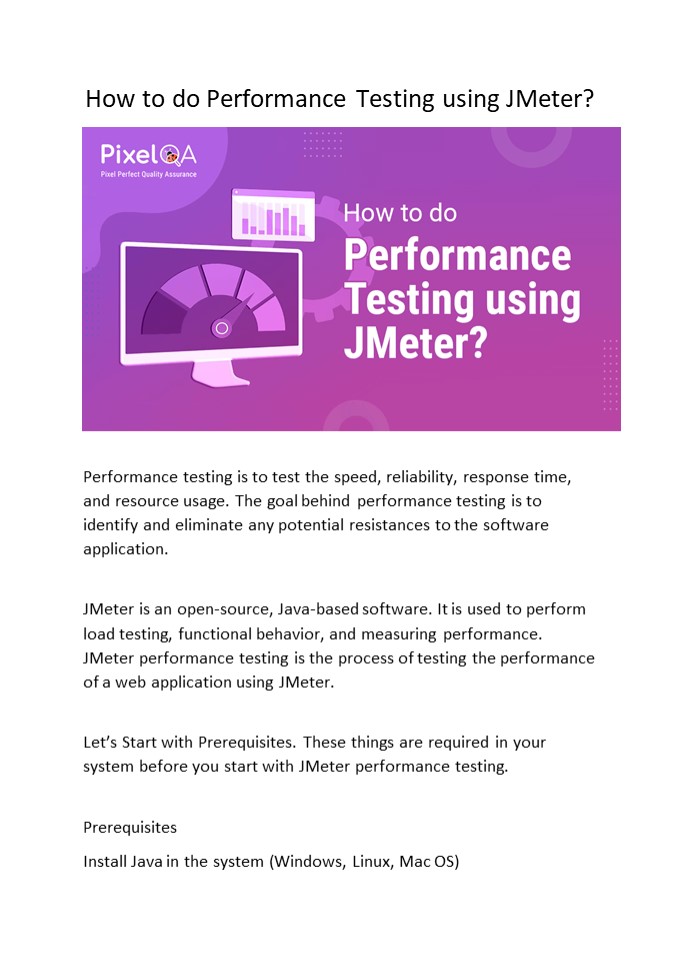How to do Performance Testing using JMeter? - PowerPoint PPT Presentation
Title:
How to do Performance Testing using JMeter?
Description:
Performance testing is to test the speed, reliability, response time, and resource usage. – PowerPoint PPT presentation
Number of Views:7
Title: How to do Performance Testing using JMeter?
1
How to do Performance Testing using JMeter?
- Performance testing is to test the speed,
reliability, response time, and resource usage.
The goal behind performance testing is to
identify and eliminate any potential resistances
to the software application. - JMeter is an open-source, Java-based software. It
is used to perform load testing, functional
behavior, and measuring performance. - JMeter performance testing is the process of
testing the performance of a web application
using JMeter. - Lets Start with Prerequisites. These things are
required in your system before you start with
JMeter performance testing. - Prerequisites
- Install Java in the system (Windows, Linux, Mac
OS)
2
Download JMeter. Click Here Install JMeter Report
Plugins To Generate report 1. Download the JMeter
plugins Click here
2. Replace the lib folder with downloaded JMeter
plugins
JMeter Performance Testing Steps (Process) Launch
JMeter
Move to the extracted folder to open the
program. Run the jmeter.bat (Windows Batch File)
3
Record JMeter Script Record JMeter script means
adding data in JMeter that is used to perform
testing. There are multiple ways to record JMeter
test case scripts for performance
testing. Method 1Adding Manual Record from
JMeter For the basic program, refer to our
previous article on JMeter Performance Testing
for Beginners. In the previous article, we have
explained manual record entry.
4
There are other methods as well to record data
for advanced users. But before you go further,
we need to setup the thread group Method 2 Use
.CSV for multiple users There are multiple steps
involved in the process of adding. CSV records.
Here is the step-by-step process to use. CSV for
multiple users entry.
5
Step 1 - Create login.csv with two columns
(username and password) and save it to your
preferred location.
Step 2 - Right Click on Thread Group Add
Config Element CSV data set config.
6
Step 3 - In Filename field, click on browse and
select the file(Login.csv) you have created.
Step 4 - Add Column names in Variable Names
field.
7
Step 5 - Right Click on Thread Group Add
Sampler HTTP Request
Step 6 - Pass the variables as Parameters in HTTP
request (Add Name Email, Value username,
Name Password, Value password ) Method 3
Use a recording tool for the JMeter script. In
this method, we need tools or extensions to
record our actions and data for JMeter script.
There are various tools and extensions to
perform such functionality. We have mentioned
three as we found them easy to use. All recorded
script is downloaded in .jmx format.
8
Badboy - you can download this tool from here.
Selenium IDE using JMeter Plugin - you can
download this plugin from here BlazeMeter
plugin - you can download this plugin from here.
This plugin is only available in the Chrome
browser.
9
Once the recording is done, you need to open file
in JMeter. For that, Go to File open. And
select recorded .jmx file/script.
Execute JMeter Script It's time to execute JMeter
script and get the result. There are two formats
to generate results in JMeter. One is Generic and
available to all, and another is advanced that
needs to install Plugin. Default Report
Format Step 1 - Right Click on Thread Group
Add Listener Result Tree
10
Step 2 - To run the JMeter program, Save the
script and Click on Run Button or Press CtrlR
Advance Report Format Using plugins In this
advance report format, we will use the report we
installed in the "Prerequisites" section of this
article. We will showcase five types of reports
11
Active Thread Over Time - - This report showcases
that how many active threads are there in
each thread group during the test run. To
generate the report, you need to Right Click on
Thread Group Add Listener click on
Active Thread Over Time.
Response Times Over Time - In this report, you
will get the amount of time it takes for a server
to respond to a client's request. To generate
the report, you need to Right Click on Thread
Group Add Listener click on Response Time
Over Time.
12
Hits per Second - This report represents the
number of requests sent to the server in one
second. To generate the report, you need
to Right Click on Thread Group Add
Listener click on Hits per Second.
13
Composite graph - As per the name, it combines
three charts in one report. This report
generates a graph with three components active
thread, server hits per second, and response
time.To create the report, you need to Right
Click on Thread Group Add Listener click
on Composite Graph.
Stepping Thread Group - It creates ramp-up and
ramp-down scenarios in steps as part of JMeter
load testing with different criteria/parameters.
To generate the report, you need to Right Click
on Thread Group Add Listener click on
Stepping Thread Group.
14
Conclusion JMeter is one of the performance
testing tools that can help expert to run
performance and load testing for web
applications. We have explained how you can
create records/data and get the test report of
your application. This way, you can improve the
performance of your application. About
Author Kevin Patel started his career as QA in
Feb 2016. Currently, he is associated with Pixel
QA as a Senior QA engineer. He has achieved two
major certificates in QA Testing in different
domains like accounting, e-commerce, healthcare,
and payroll. He loves challenges, team
handling, and client communication. He would like
to progress in his career as QA Consultant in the
IT field by achieving more QA standards.

